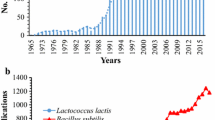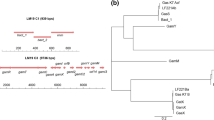Abstract
Strains of Enterococcus faecalis and Lactobacillus sake have been found to express lantibiotics with unusual properties. The enterococcal lantibiotic is unusual in that it consists of two dissimilar subunits, both putatively containing modifications consistent with those found in other lantibiotics. The enterococal lantibiotic is also unusual in the number of proteolytic steps involved in secretion signal removal and activation. Moreover, it has been observed to contribute to enterococcal disease in humans and in animal models. Structrural studies of lactocin S, expressed by a strain of L. sake highlight unique properties including the presence of D-alanine within its structure, and a protease putatively responsible for lactocin S secretion signal peptide removal which, itself, lacks a signal or propeptide sequence. Despite the unusual properties of each of these lantibiotics, the operons encoding each, and accompanying auxiliary functions, are collinear suggeting a common ancestry. The accretion of interdigitating DNA sequences between genes encoded within the lactocin S determinant are unique to that determinant, however, and are of unknown function.
Similar content being viewed by others
References
Abildgaard CIM (1992) Lactocin S, a lanthionine-containing bacteriocin from Lactobacillus sake. Ph.D. thesis, Agricultural University of Norway, As, Norway
Bogie CP, Hancock LE & Gilmore MS (1995) The Enterococusfaecalis cytolysin determinant and its relationship to those encoding lantibiotics. In: Ferretti JJ, Gilmore MS & Klaenhammer T (Eds) Genetics of Streptococci, Enterococci and Lactococci Molecular Biology of Streptococci. In press
Brock TD & Davie JM (1963) Probable identity of a group D hemolysin with a bacteriocine. J. Bacteriol. 86: 708–712
Brock TD, Peacher B & Pierson D (1963) Survey of the bacteriocines of enterococci. J. Bacteriol. 86: 702–707
Chow JW, Thai LA, Perri MB, Vazquez JA, Donabedian SM, Clewell DB & Zervos MJ (1993) Plasmid-associated hemolysin and aggregation substance production contributes to virulence in experimental enterococcal endocarditis. Antimicrob. Agents Chemother. 37: 2474–2477
Fath MJ & Kolter R (1993) ABC transporters: Bacterial exporters. Microbiol. Rev. 57: 995–1017
Clewell DB, Tomich PK, Gawron-Burke MC, Franke AE, Yagi Y & An FY (1982) Mapping of Streptococcus faecalis plasmids pAD1 and pAD2 and studies relating to transposition of Tn917. J. Bacteriol. 152: 1220–1230
Gilmore MS, Segarra RA, Booth MC, Bogie CP, Hall LR & Clewell DB. Genetic structure of the Enterococcus faecalis plasmid pAD1-encoded cytolytic toxin system and its relationship to lantibiotic determinants. J. Bacteriol. 176: 7335–7344
Granato PA & Jackson RW (1969) Bicomponent nature of lysin from Streptococcus zymo genes. J. Bacteriol. 100: 856–868
Haandrikman AJ, vanLeeuwen C, Kok J, Vos P, deVos WM & Venema G (1990) Insertion elements on lactococcal proteinase plasmids. Appl. Environ. Microbiol. 56: 1890–1896
Higgins CF, Causton HC, Dance GSC & Mudd EA (1993) The role of the 3′ end in mRNA stability and decay, pp 11–30. In: Belasco J & Brawerman G (Eds) Control of messenger RNA stability Academic Press, San Diego
Huycke MM, Gilmore MS, Jett BD & Booth JL (1992) Transfer of pheromone-inducible plasmids between Enterococcus faecalis in the Syrian hamster gastrointestinal tract. J. Infect. Dis. 166: 1188–1191
Huycke MM, Joyce WA & Gilmore MS (1995) Enterococcus faecalis cytolysin without effect on the intestinal growth of susceptible enterococci in mice. J. Infect. Dis., 172: 273–276
Huycke MM, Spiegel CA & Gilmore MS (1991) Bacteremia caused by hemolytic, high-level gentamicin-resistant Enterococcus faecalis. Antimicrob. Agents Chemother. 35: 1626–1634
Ike Y, Clewell DB, Segarra RA & Gilmore MS (1990) Genetic analysis of the pAD1 hemolysin/bacteriocin determinant in Enterococcus faecalis: Tn917 insertional mutagenesis and cloning. J. Bacteriol. 172: 155–163
Ike Y, Hashimoto H & Clewell DB (1984) Hemolysin of Streptococcus faecalis subspecies zymogenes contributes to virulence in mice. Infect. Immun. 45: 528–530
Ike Y, Hashimoto H & Clewell DB (1987) High incidence of hemolysin production by Enterococcus (Streptococcus) faecalis strains associated with human parenteral infections. J. Clin. Microbiol. 25: 1524–1528
Jett BD, Huycke MM & Gilmore MS (1994) Virulence of enterococci. Clin. Microbiol. Rev. 7: 462–478
Jett BD, Jensen HG, Nordquist RE & Gilmore MS (1992) Contribution of the pAD1-encoded cytolysin to the severity of experimental Enterococcus faecalis endophthalmitis. Infect. Immun 60: 2445–2452
Jett BD, Jensen HG, Atkuri RV & Gilmore MS (1995) Evaluation of therapeutic measures for treating endophthalmitis caused by isogenic toxin-producing and toxin-nonproducing Enterococcus faecalis strains. Invest. Ophthalmol. Vis. Sci. 36: 9–15
Kreil G (1994) Peptides containing a D-amino acid from frogs and molluses. J. Biol. Chem. 269: 10967–10970
Mørtvedt CI & Nes IF (1990) Plasmid-associated bacteriocin production by a Lactobacillus sake strain. J. Gen. Microbiol. 136: 1601–1607
Mørvedt CI, Nissen-Meyer J, Sletten K & Nes IF (1991) Purification and Amino Acid Sequence of Lactocin S, a Bacteriocin Produced by Lactobacillus sake L45. Appl. Environ. Microbiol. 57: 1829–1834
Nes IF, Mørtvedt CI, Nissen-Meyer J & Skaugen M (1994) Lactocin S, a lanthionine-containing bacteriocin isolated from Lactobacillus sake L45, p. In: DeVuyst L & Vandamme EJ (Eds) Bacteriocins of lactic acid bacteria. Blackie Academic and Professional, Glasgow
Pouwels PH & Leer RJ (1993) Genetis of Lactobacilli. Plasmids and gene expression. Antonie van Leeuwenhoek 64: 83–105
Rince A, Dufour A, LePogam S, Thuault D, Bourgeois CM & LePennec JP (1994) Cloning, expression, and nucleotide sequence of genes involved in production of lactococcin DR, a bacteriocin from Lactococcus lactis subsp. lactis. Appl. Environ. Microbiol. 60: 1652–1657
Sahl H-G (1991) Pore formation in bacterial membranes by cationic lantibiotics, p. 347–358. In: Jung G & Sahl H-G (Eds) Nisin and Novel Lantibiotics. ESCOM, Leiden
Schnell N, Entian K-D, Schneider U, Götz F, Zähner H, Kellner R & Jung G (1988) Prepeptide sequence of epidermin, a ribosomally synthesized antibiotic with four sulphide-rings. Nature 333: 276–278
Segarra RA, Booth MC, Morales DA, Huycke MM & Gilmore MS (1991) Molecular characterization of the Enterococcus faecalis cytolysin activator. Infect. Immun. 59: 1239–1246
Siezen RJ, deVos WM, Leunissen JAM & Dijkstra BW (1991) Homology modeling and protein engineering strategy of subtilases, the family of subtilisin-like serine proteinases. Protein Eng 4: 719–737
Skaugen M & Nes IF (1994) Transposition in Lactobacillus sake and its abolition of lactocin S production by insertion of IS1163, a new member of the IS3 family. Appl. Environ. Microbiol. 60: 2818–2825
Skaugen M, Nissen-Meyer J, Jung G, Stevanovic S, Sletten K Abildgaard CIM & Nes IF (1994) In vivo conversion of L-serine to D-alanine in a ribosomally synthesized polypeptide. J. Biol. Chem. 269: 27183–27185
Skaugen M, Abildgaard CIM & Nes IF. Analysis of genes involved in the biosynthesis of the lantibiotic lactocin S. Manuscript in preparation.
Todd EW (1934) A comparative serological study of streptolysins derived from human and from animal infections, with notes on pneumococcalhaemolysin, tetanolysin and staphylococcus toxin. J. Pathol. Bacteriol. 39: 299–321
VonHeijne G (1983) Pattern of amino acids near signal-sequence cleavage sites. Eur. J. Biochem. 133: 17–21
Author information
Authors and Affiliations
Rights and permissions
About this article
Cite this article
Gilmore, M.S., Skaugen, M. & Nes, I. Enterococcus faecalis cytolysin and lactocin S of Lactobacillus sake . Antonie van Leeuwenhoek 69, 129–138 (1996). https://doi.org/10.1007/BF00399418
Issue Date:
DOI: https://doi.org/10.1007/BF00399418




